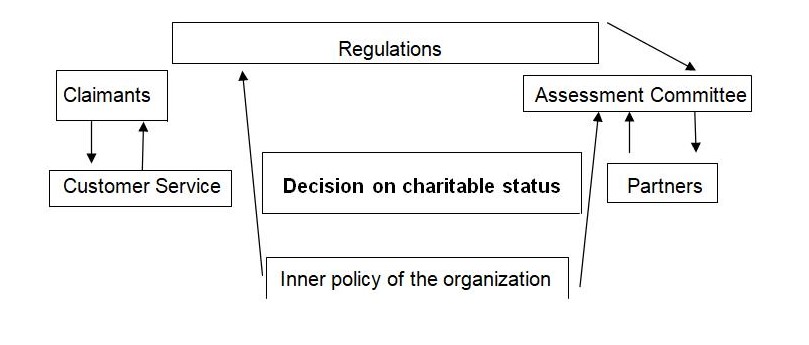Introduction
Charity Commission is a public sector organization, which is responsible for regulating charities in the United Kingdom, in other words, it decides on the charitable or uncharitable status of a person or a public body, asking for financial assistance. It is a non-governmental agency because it is subordinate only to the UK Parliament (Charity Commission, pp 7-10). The structure and process of decision making in this organization can be described in the graphical way.

In order to evaluate the efficiency or inefficiency of any public organization, it is necessary to view it as a system. Therefore, each system can be divided into sub-systems or constituent parts. In this case, claimant is a person or organization, which requires financial assistance. To some extent, it is also a part of the system (or the subsystem), thus there are ways to investigate it. Probably, qualitative research methods will be more preferable, in particular, unstructured interview. Interviewees can provide valuable information as to the efficiency of the organization (Charity Commission), whether there are some bureaucratic difficulties that they have to surmount. Claimants can also propose ways to simplify the procedure of obtaining charitable status. However, it is also possible to employ quantitative research methods, for example statistical survey, because such approach is not as time-consuming as the oral interview.
Customer Service. Such elements of the system as customer service and claimants are closely intertwined. In order to study this component, the researcher should take a complex approach, for instance, it is quite possible to conduct a survey among customers as to the efficiency of this department. In this particular case, the structured interview with scaling questions (also known as Likert scale) will be the most useful. Additionally, the employees of customer service should be interviewed, because they can propose some amendments, which can contribute to the effective functioning of their department.
Regulations. It is possible to single out three sets of regulations: the system of charity regulations, the system of financial regulations and the system of organizational regulations. The claimant has to refer to each of them. They should be studied as a complex. Logical and statistical analysis can show whether these regulations arise any controversy, or dubious interpretation (Philanthropic Research, pp 90-96). Additionally, it is necessary to illustrate the relationships between the official regulations and the inner policy of the organization (Charity Commission), whether they are always in harmony or there is some discordance between them.
Inner policy of the organization. In order to study the inner policy of the organizations, one should analyze recent decisions made by the Charity Commission, especially whether they do not contradict the existing legislation (Charities Act 2006). Moreover, it is of the crucial importance to show whether this policy simplifies or hinders the procedure. This can be done by means of logical analysis and statistical survey.
Partners: Charity Commission closely cooperates with other agencies, in particular with HMRS (Revenue Service), which provides information to the Charity Commission about the financial activity of the claimant. The primary purpose of such collaboration is to establish the flow of information between these organizations. The evaluation of such multi-agency practice can be performed by means of SWOT analysis. It can identify inner qualities of the organization (which can promote or hinder effective multi-agency practice). Furthermore, the researcher should ascertain external factors, which may prevent organization from achieving the assigned task.
Bibliography
- Great Britain. Charity Commission (2002). Report of the Charity Commissioners for England and Wales: Year Ending 2002.
- Harry James White, Selmo Tauber (1969). Systems Analysis. Saunders.
- Philanthropic Research, Inc, Inc Philanthropic Research (1998). GuideStar: The National Database of Nonprofit Organizations. Philanthropic Research.
- Philip C. Semprevivo (2007). Systems Analysis: Definition, Process, and Design. Science Research Associates.